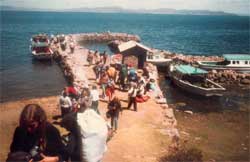The committee considers this film as an exceptional contribution to the current worldwide problem of old cultures trying to survive under the pressure of the organized tourism. The advantages of the film are most of all the patience in collecting the films material, the detailed and precise observations, and the impact of the picture. The sparingly use of text concentrates on important passages without ever becoming talkative or lofty. Also the music is used sparingly while always keeping the relation to the topic and the situation. The calm rhythm of the camera work and the editing are carried over to the viewer and leads him to a deeper and emotional understanding of the discussed topic…
| From the advisory opinion of the agency for film evaluation, 12/19/1985 |
The Lake Titicaca is the world’s highest navigable lake – in the Andes between Peru and Bolivia. Here in the bay of Puno lie the swimming islands of the Urus, which consist of reed - a very exotic destination, which none of the tourists of Peru want to miss. Up to fifteen times a day they are invaded by boats with tourists during the main season. It makes no difference in their behaviors, whether they are Latin Americans, US Ameri-cans, Germans or Frenchmen. They take a picture of every cooking pot and are glad, that the ‘wild’ Uru children sing for them in German the children rime “Alle meine Entchen” or – if it has to be – they even sing a Japanese song. want to miss. Up to fifteen times a day they are invaded by boats with tourists during the main season. It makes no difference in their behaviors, whether they are Latin Americans, US Ameri-cans, Germans or Frenchmen. They take a picture of every cooking pot and are glad, that the ‘wild’ Uru children sing for them in German the children rime “Alle meine Entchen” or – if it has to be – they even sing a Japanese song.
The Urus, who started the day leisurely with their different activities like fishing, hunting for birds, and preparing food, are completely changed from the moment on, when the tourists arrive. The laughter of the children dies and bargaining starts everywhere.
Only when the last boat of the day has left, the restfulness returns to the island. The cruel living conditions come into the picture; and also, how badly the Urus need the few banknotes, which they earn by selling their embroideries and their stuffed birds to the tourists.
On the other hand how unfair is the discrimination, which the Urus experience for centuries. In history, because they didn’t commit themselves to forced labor for the Inkas and Aymaras, today, because they need to allow to be characterized as “touristic infested”.
At the most tourists say lapidary: “I cannot imagine someone spending his whole life in such a reed hut”.
When leaving the swimming islands by motorboat you will come to Taquile after two hours. The Taquilenos organize the tourism on their own initiative. While the Urus had to put up with the strangers for twenty years without having the possibility to change anything, the Taquilenos on the other hand try to “take advantage of the tourism” (as the “South American Handbook” blames them) without giving up their culture at the same time.
| Press information about the film, 1985 |
| 